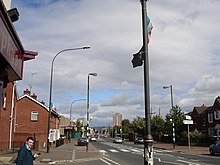Falls Road, Belfast

Falls Road looking towards Divis flats and the city centre.
|
|
| Maintained by | Belfast City Council |
|---|---|
| Location | Belfast, Northern Ireland |
| Coordinates | 54°35′36″N 5°57′30″W / 54.59347°N 5.95823°WCoordinates: 54°35′36″N 5°57′30″W / 54.59347°N 5.95823°W |
| Northeast end | Divis Street |
| Southwest end | Andersonstown Road |
The Falls Road (from Irish túath na bhFál, meaning 'territory of the enclosures') is the main road through west Belfast, Northern Ireland, running from Divis Street in Belfast city centre to Andersonstown in the suburbs. Its name is synonymous with the republican community in the city, whilst the neighbouring Shankill Road is predominantly loyalist, separated from the Falls Road by peace lines. The road is usually referred to as the Falls Road, rather than as Falls Road. It is known as the Faas Raa in Ulster-Scots.
The Falls Road derives its name from the Irish túath na bhFál, an Irish petty-kingdom whose name means "territory of the enclosures". This territory was roughly the same as that of the ecclesiastical parish of the Shankill, which spanned a large portion of modern-day Belfast.
The Falls Road itself was originally a country lane leading from the city centre but the population of the area expanded rapidly in the 19th century with the construction of several large linen mills. All of these have now closed or have been repurposed. This original area, which was centred on the junction of modern-day Millfield and Hamill Street on what is now Divis Street, was known as Falls and lent its name to the road, which had previously been called "the Pound". The housing in the area developed in the 19th century and was organised in narrow streets of small terraced housing. Many of these streets were named after characters and events in the Crimean War (1853–1856) which was occurring at that time.
These included Raglan Street (named after Lord Raglan, commander of British forces in the Crimean War), Alma Street (named after the Battle of Alma), Balaklava Street (named after the Battle of Balaklava), Inkerman Street (named after the Battle of Inkerman), and Sevastopol Street (named after the Siege of Sevastopol).
...
Wikipedia
